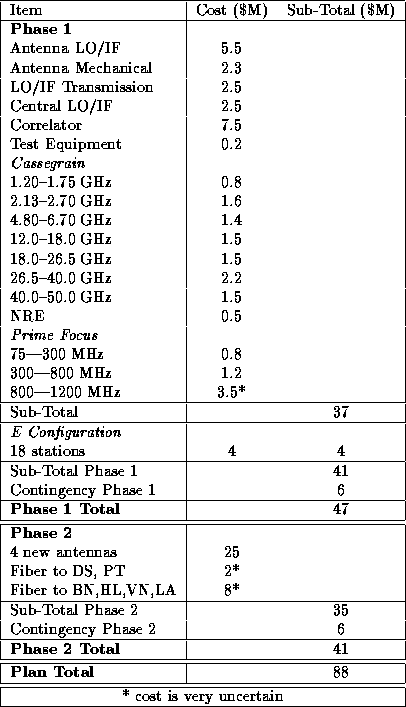 out of every 5 antennas)
out of every 5 antennas)
The time scale for carrying out the VLA Development Plan is uncertain, as many engineering aspects of the plan have yet to be defined. The amount of work that will be contracted out and the amount that will be done by NRAO staff are also not yet decided. A fundamental requirement is that the VLA should continue to function as a user instrument while the enhancements are introduced. The impact of this on cost and schedule is presently uncertain, and requires detailed study. Nonetheless, some estimates can be made.
The time scale for the work on the Plains of San Augustin (Phase 1) will probably be set by the need to move antennas through the Antenna Assembly Building for overhaul. The tasks will include:
 out of every 5 antennas)
out of every 5 antennas)
Allowing 4 antennas to have an 8 week overhaul and one antenna to have a 12 week overhaul (for the azimuth bearing replacement), the work on five antennas can be completed per year. This will be a tight schedule and will probably involve working two shifts per day. With 28 antennas, and adding a few months for startup and cleanup, the upgrade project will take 6 years. During that time there will often be two antennas out of the observing array for retrofits.
Six new cryogenic systems (including finishing 45 GHz) will be added to the array; a total of 170 cryogenic receivers will need to be built. Even if design and prototyping can be done before the main project begins, we still need to fabricate about 30 cryogenic receivers per year. During our normal receiver retrofit program we have built between 9 and 12 receivers per year. About 800 new LO/IF modules will have to be built.
Six years should be adequate time to complete the fiber optics system, the new correlator, and E configuration stations. At least two years of design and prototyping should precede the actual project start. If 1996 and 1997 are devoted to R&, the parts of the upgrade that will be located on the Plains of San Augustin could be completed in 2003. As the normal VLA and VLBA maintenance and upkeep must be kept going throughout Phase 1, we will need to add about 30 people to the Engineering Services and Electronics Divisions for its six-year duration.

Table 5.1: Illustrative Budget
Table 5.1 gives an illustrative budget for all items in the VLA Development Plan.
Computing costs, other than for on-site control of the new antennas and the new correlator, are not explicitly included in this budget. They change more rapidly than other items (fortunately tending to decrease) with time. They will therefore be estimated closer to the time of requesting funds.
The antenna-based items in Phase 1 are costed only for the 28 antennas now in the VLA. The cost estimates for the receivers and feeds are based on recent NRAO experience with similar systems for the VLA and VLBA, and include the costs of material and labor.
The budget for the correlator includes material and manpower costs, including software. It is based on an estimate using a lag design and the VLBA correlator manpower experience. Note that all aspects of the design need more study, but that designs that would increase the cost above this estimate are likely to be discarded for that reason.
The VLA Expansion is considered as a separate phase of this plan for several reasons. It requires the prior completion of the new correlator. Its scientific effectiveness is dramatically increased by the enhanced bandwidth and improved receivers specified in Phase 1. The NRAO also needs some hands-on experience with long fiber optic links to determine the feasibility and operating costs of Phase 2. Unlike Phase 1, Phase 2 will bring significantly increased operating costs-for the fiber links and for the new remote antennas. It can however be done with minimal disruption to the operation of the existing array. If its technical feasibility could be evaluated in more detail soon, its time-scale once funded could be paced by the antenna construction and outfitting and thus be shorter than that of Phase 1.
The cost estimate for the four new antennas is based on the VLBA experience and includes their control systems, feeds, receivers and associated electronics (including VLBA recorders) as well as site development. The cost estimate for the long fiber links is highly uncertain for the reasons outlined earlier.
As many of the scientific benefits of the VLA Development Plan depend on both Phase 1 and Phase 2, it would be very attractive to complete Phase 2 soon after, or simultaneously with, Phase 1. Their staging could however also be adjusted to match the availability of funding.